Let’s chat about the challenge of matching the correct spelling for /ch/ when you have a bunch of ways to spell it. It really is a cinch if you ditch the guessing and snatch the rule from this catch-y blog entry!
Okay, okay, enough of that chatter. Yes, I suppose I am a much better teacher than I am a poet, but the sentiment remains the same. Many of our students struggle with the correct spelling for the sound /ch/.
Why is that?
Let me divert for a moment to an analogous story...
As a child growing up in small-town Wisconsin, I discovered that if I wanted to be one of the “cool kids,” I had to learn how to bowl. So, I took to the lanes trying every method imaginable.
 1. Photo by Michelle McEwen on Unsplash
1. Photo by Michelle McEwen on Unsplash
In an attempt to keep my ball out of the gutter, I tried bowling right-handed, left-handed, and sometimes even two-handed! Should I walk or run up to the lane? Well, needless to say, this wasn’t a very efficient way to get better at bowling. I finally asked a friend to teach me how to bowl. It turns out, there are strategies for every possible bowling situation! As an awkward preteen, I would have never guessed these strategies on my own.
This is not unlike our students who struggle with spelling, grasping at any possible spelling combination until they settle on one that might look right. On the other hand, explicit instruction of spelling rules removes the guesswork from spelling, allowing our students more mental space for all of that fantastic writing content!
Now, back to the topic of spelling /ch/…
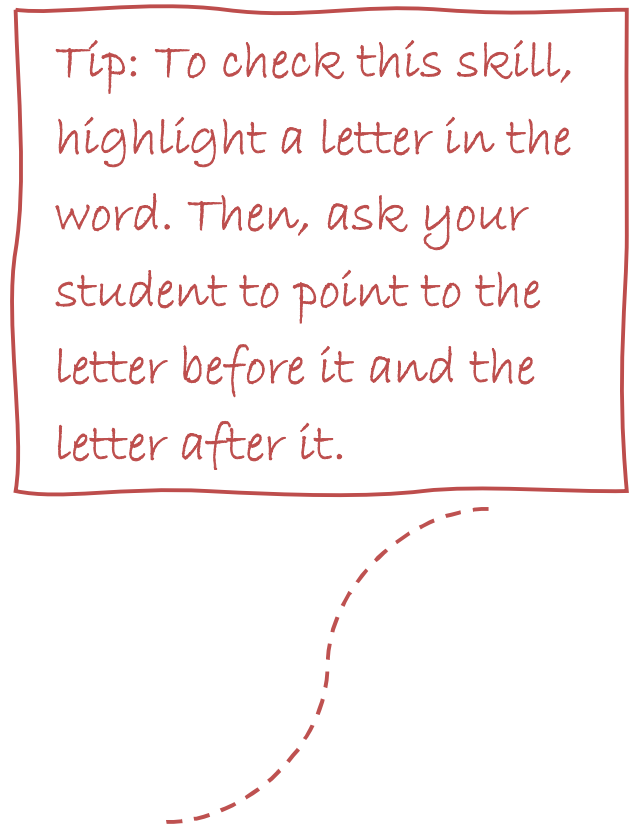 Let’s talk about prerequisite knowledge first.
Let’s talk about prerequisite knowledge first.
Your student will need the following skills before you can begin teaching
this rule:
Now that we have our “ingredients” sorted out, let’s get to cooking! I know, the metaphors are getting a bit tiring, so let me add some clarity. Here’s our rule:
“Always use TCH after a short vowel—otherwise use CH.”
Here at Silver Moon, we can’t have a spelling rule without a catchy phrase to help us remember it, and this one is absolutely delicious!
Munch a Batch of Cookies

This rule brings back the multisensory experience of indulging in a fresh batch of fresh, gooey chocolate chip cookies. Here’s how that rule shakes out:
Munch reminds us that we use a CH after a consonant (or long vowel).
Batch reminds us that we use TCH after a short vowel.
Exceptions to the Rule:
There are a few words that break this rule! These words are:
*Such *Much *Rich *Which
If you’re a busy parent or teacher, you probably don’t find yourself with loads of time on your hands. That’s why I created the following FREE reproducibles. And the best part? All the work is done for you. Just print and teach!
Munch a Batch of Cookies Reproducibles
If you found this blog helpful, you can find our other spelling topics HERE, and don’t forget to check out our complete guide to spelling at www.Silvermoonspellingrules.com
 2. Photo by Food Photographer | Jennifer Pallian on Unsplash
2. Photo by Food Photographer | Jennifer Pallian on Unsplash
Written by:
Kate Wagner, BSE
Reading Interventionist, Remote Learning Coach
Have you observed your student struggling to spell the /k/ sound? If so, this might look familiar:
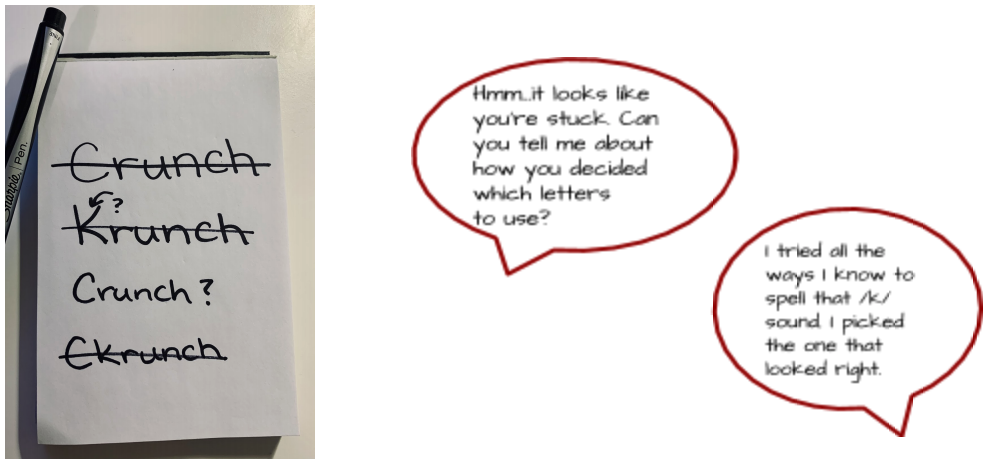
Of course, we want our students to use efficient and logical strategies while spelling, so we teach them spelling rules. I’m about to show you two handy rules that will clear up the /k/-Conundrum once and for all!
Before You Begin Teaching...
To begin, make sure your student has already mastered the following skills:
Once you’re sure that the prerequisite skills are met, you can begin to teach the spelling rule.
Spelling /K/ Explained with Two Simple Rules...
Begin by explaining that what you’re about to teach works when spelling /K/ at the beginning of a word. Spelling /K/ at the end is a bit different. I like to introduce this rule by first reminding my students to think about spelling in these simple terms:
“Say the sound you want to spell. Then, think about all of the ways you can spell that
sound.”
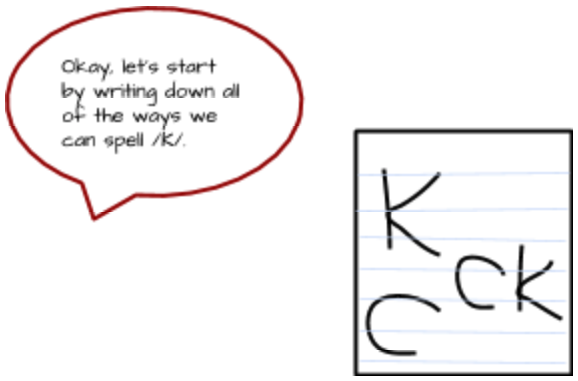
Yes, it’s that easy!
Next, explain the digraph “CK” cannot be used to begin a word. This is the point where most students breathe a sigh of relief. Now there are only two choices!
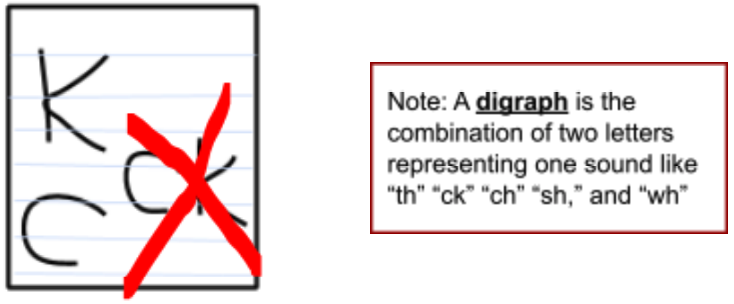
Okay, But What about the Rules?
Ahh..you’ve come here for the rules! That’s right. Because this concept relates to multiple scenarios we’ve split them into two categories named by the following two rules:
Cubs Can Drink Cola

The most common way to spell /K/ is with the letter “C,” so we should always consider spelling with the letter “C” first.
However, sometimes, the letter “C” can be tricky. When it comes right BEFORE a Sssssneaky Vowel, it will make the /S/ sound (like in the word “cent”). Sssssneaky vowels include e, i, and y.
“Spell /K/ with a C if there’s an a, o, u, or consonant after it.”
Kind Ken Was Stinky

And what to do if there is a Sssssneaky Vowel? Easy! Just choose the other option, “K.”
“Spell /K/ with a K if there’s an e, i, or y after it.”
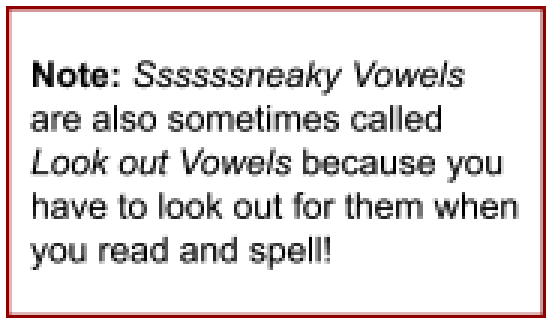
How cute are Ken and those Cubs?! As much as I’d like to say they were created just to melt our hearts, they serve an important role in rule memorization. In fact, when students can connect a new concept to a story, visual, and mnemonic device, they are much more likely to apply and remember this new knowledge!
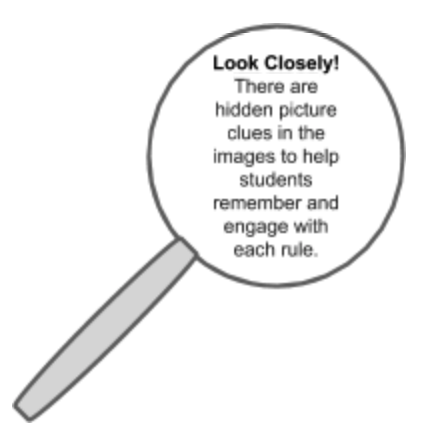
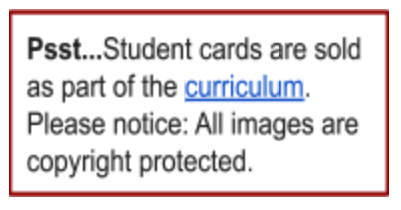
Important Tips To Consider...
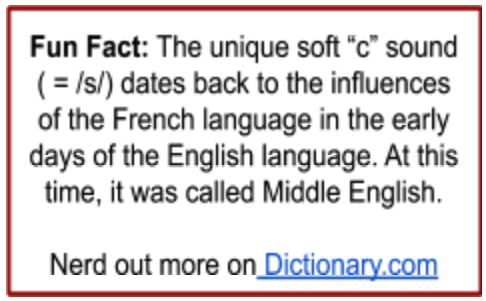
Remember: We teach spelling rules to students so that they don’t have to use inefficient strategies like guessing. However, don’t become discouraged if your student still reverts to guessing strategies. This compensatory skill is most likely still a knee-jerk reaction to spelling unfamiliar words! When this happens, keep bringing your student back to the rules they’ve learned.
Free Reproducibles!
Practice these skills with our FREE resources.
Download to Print: Spelling _k_ Worksheets and Answer Keys Combined (1)
If you’ve found this article useful for solving your /K/-Conundrums, please share this post! Don’t forget to check back for more spelling and reading discussion, tips, and resources.
Check out the rest of our spelling rules at www.Silvermoonspellingrules.com
Happy Teaching!
Written by:
Kate Wagner, BSE
Reading Interventionist, Remote Learning Coach
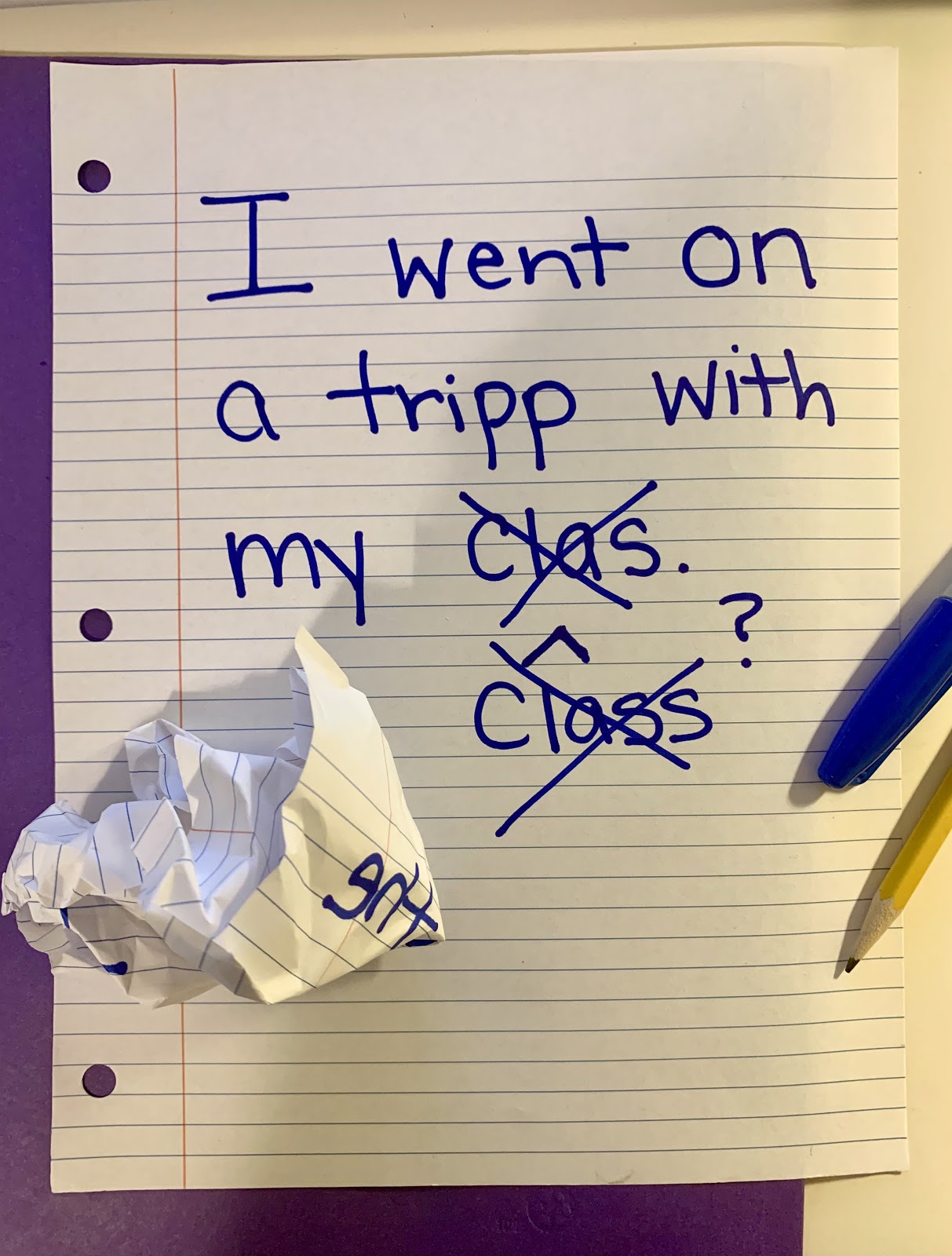
As educators and parents of struggling spellers, we all can relate to the writing sample above. Students are often confused about how to double letters when they come at the end of a word. As seen in the word “tripp,” struggling spellers will often over-generalize doubling rules in an attempt to make sense of the spelling patterns that they’ve noticed on their own. This is neither unique nor irreparable; all you need are the tools to teach the rules!
A Quick Note About Generalization…
Generalization is the skill used to apply one concept to many different situations. Generalization is often used in a positive way, and in education, we celebrate those moments our students generalize skills that we’ve explicitly taught as it often demonstrates mastery. In the spelling world, note that the words ‘generalization’ and ‘rule’ may be used to mean the same thing. Kelly Steinke, author of Silver Moon Spelling Rules, describes the reasoning for this in her up and coming book, Silver Moon Spelling Rules, Set 3.
“The term ‘spelling rule’ will be used interchangeably with the term ‘spelling generalization’. This is because, at this point, students need to use critical thinking skills to consider possible spelling choices when there may be more than one way to spell a given sound. Spelling rules are a construct, or way to think about and organize spelling choices.”
Silver Moon Spelling Rules, Set 3 © 2021
And yet, there is such a thing as over-generalization. This is that all-too-familiar phenomenon where a student takes a self-appointed spelling pattern and applies it to the wrong situations (as seen above in the writing sample). Think of this like that moment that you learned dessert comes after dinner. As soon as you generalized this “rule,” you might have begun to expect dessert after EVERY meal. I’m sure you learned quickly that this simply wasn’t a rule that you could generalize to each meal, or perhaps you’re like me and still learning.
Back to Doubling…
Okay, so your student has some confusion over doubling. What now? It sure would be nice to simply tell your student the rule (often called the FLOSS rule) and fix the issue right there! However, we know we need a bit more than that to reach our students. Well, don’t panic because I’d like to share an engaging, multisensory set of strategies and FREE resources to alleviate the stress of tackling the doubling hurdle.
Before You Begin…
To begin, make sure your student has already mastered the following skills:
(mat= 1 vowel and 1 syllable, picnic= 2 vowels and 2 syllables)
*Note the exceptions: vowel teams and some silent ‘e’ syllables
Once you’re sure that the prerequisite skills are met, you can begin to teach the spelling rule.
Sam Loves Fried Zucchini…
Did I catch your interest? Good. That’s the goal. This fun phrase was created to help students remember the doubling rule. You may be familiar with the traditional mnemonic FLOSS. And while this is a handy mnemonic that has been used for many years, it’s not very engaging. That’s how Sam and his fried zucchini were born.
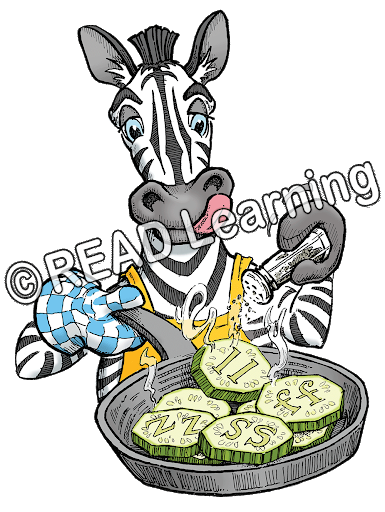
If you’re not familiar with this doubling rule, let me tell you how it goes:
“At the end of a word that has one vowel, double the letters F, L, S, and Z.”
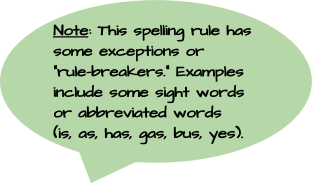 There are two components to this rule:
There are two components to this rule:
So, with that knowledge, let’s revisit our catchy phrase again:
Sam Loves Fried Zucchini
Notice that the first letter to each word represents one of the four letters that will be doubled using this rule. Pretty nifty!
Important Tips To Consider...
The easiest way to practice this skill is to give your student a list of words. Have your student find and circle all words with 1 syllable on the page by counting the vowels. Then, have your student read each 1 syllable word out loud.
Rather, provide the student with a resource that already has the rule written down for them. I highly suggest the Silver Moon Spelling Rules cards complete with illustrations of Sam and his fried zucchini. Both student and instructor sets of cards can be found at this handy link.
You may find that students have learned to memorize a lot of words. This is especially common when working with older students. Therefore, it’s difficult to know for sure if your student has really learned the spelling rule to the point of generalization (note that this is the ‘good kind’ of generalization). Using a mix of real words and nonsense words helps you better understand what your student knows and eliminates the memorization variable.
It may seem obvious to us, but it’s not always obvious to emerging readers and spellers.
And On to the Free Resources...
Okay, okay...if there’s one thing I’ve learned as a teacher, FREE resources rock! Download, print, and enjoy these free reproducibles to practice our new rule.
Sam Loves Fried Zucchini Reproducibles
As you can see, this is a really fun way to teach doubling that you can use with your students! I hope you give it a try and, if you love it, share this article with someone else.
Check out the rest of our spelling rules at www.Silvermoonspellingrules.com
If you want to see how the free reproducible work, check out this vlog where Kelly and Kate discuss the blog and the sheets!
Written by:
Kate Wagner, BSE
Reading Interventionist, Remote Learning Coach